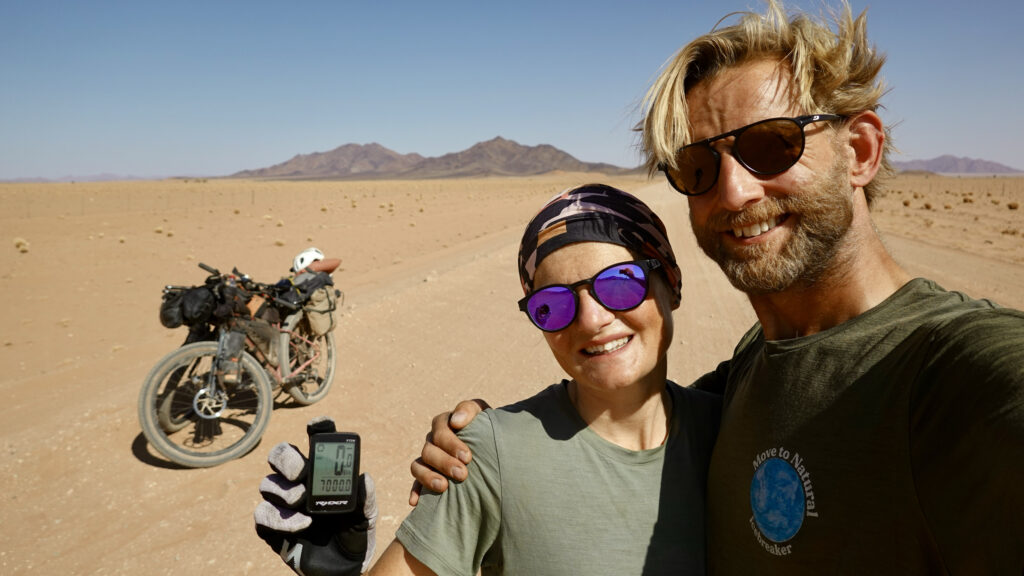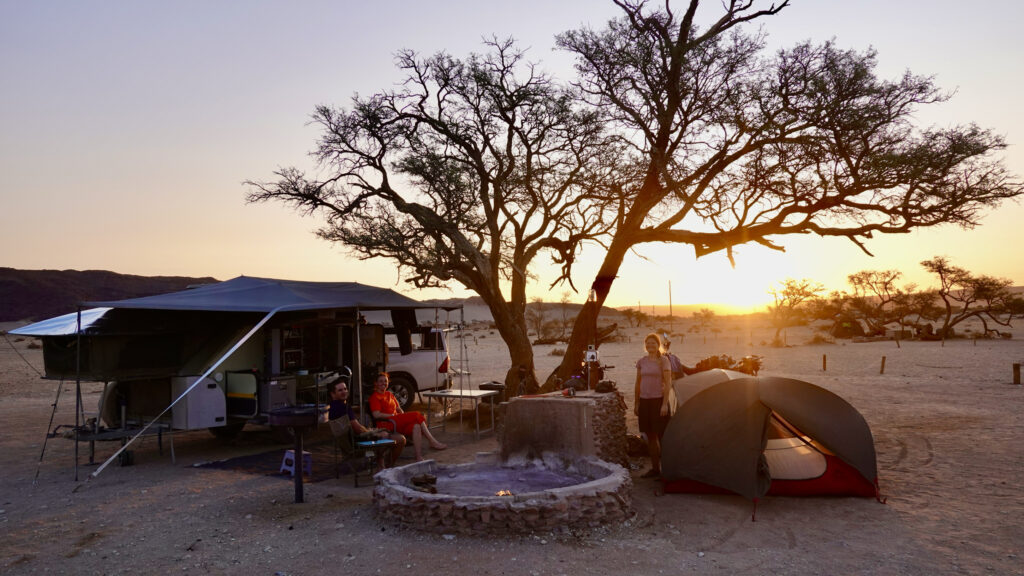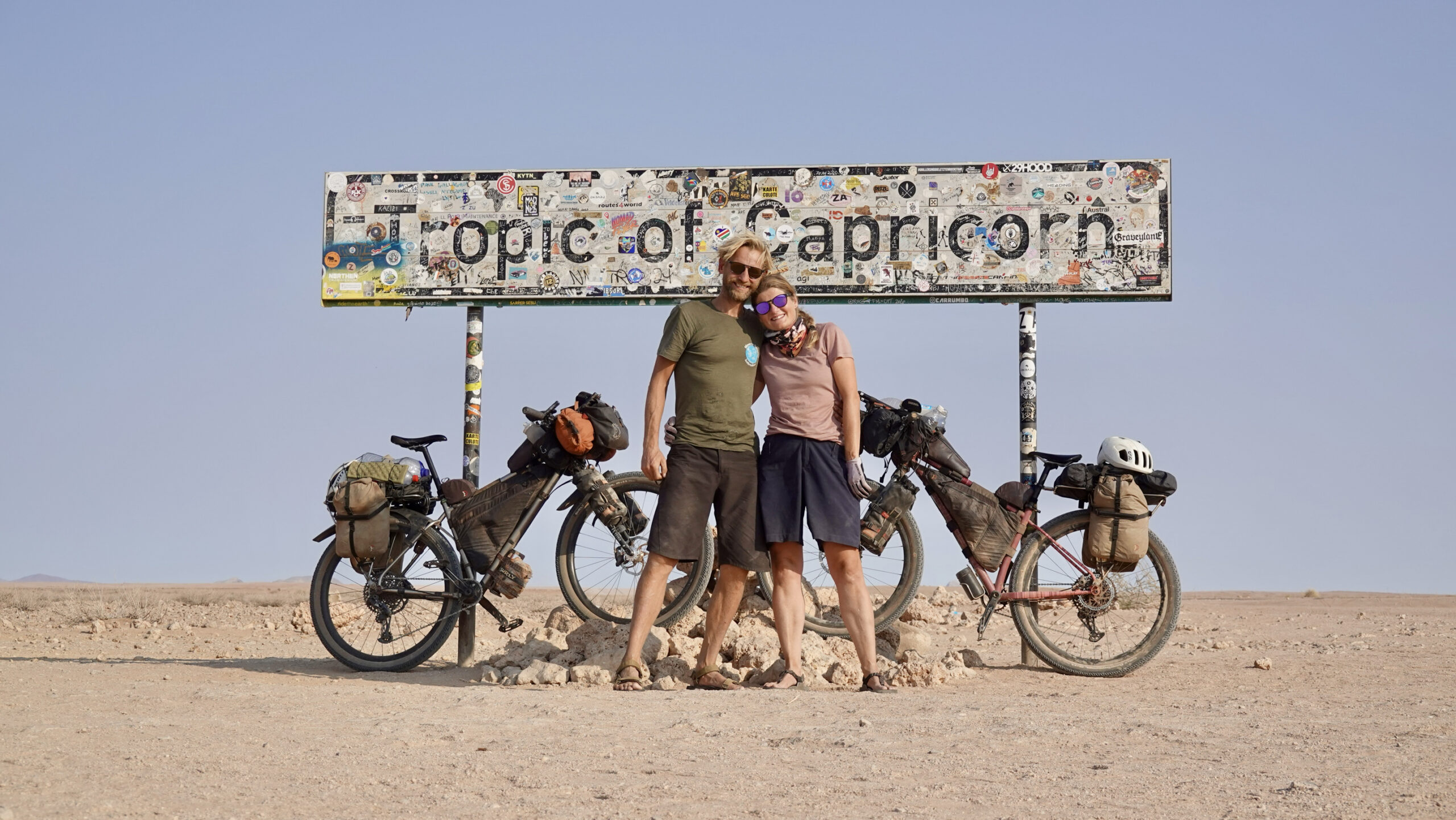After ten days in Swakopmund with delicious food, good coffee, reunion with traveling friends and meeting new friends, we are again ready to cycle south in Namibia. This time we have approx. 1200km of dirt road ahead of us. Technically, the route is easier, but there is still a long way between water and supplies. It is clearly also the most touristic area we have cycled in, but that is understandable, as the area hides some of the most fantastic natural phenomena on the journey.
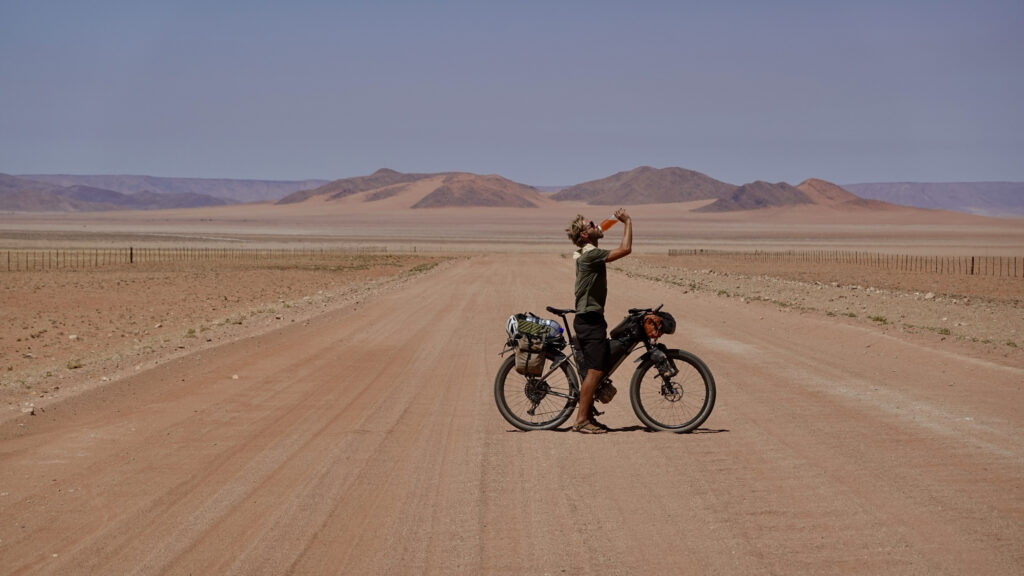
D707 – famous and infamous
The dirt road D707 goes by the name 'Namibia's most iconic dirt road'. So of course we had to cycle it. It is a real pleasure with lots of washboard. We still have approx. 10 liters of water each on the bike, as it is 140 km to the next water station. The combination of the dry wind hitting us in the face with the sun grilling us makes us feel a bit like the biltong we carry in our bags as snacks. Biltong is dried meat and a Namibian delicacy.


The roads have changed since we cycled from Swakopmund approx. in the middle of Namibia. From the winding small four-wheel drive roads, we now cycle on larger dirt roads, which are full of washboards. They are not technically difficult and therefore fun, but they are not easy either. They are just annoying. We must constantly concentrate on the road and find a good track to cycle. So there is not the same time to scout out the beautiful landscape. Fortunately, we can stop and enjoy the landscape, which we do, but we also have to move forward.
The D707 winds through mountainous landscapes in beautiful colors and with long straight roads where we cycle and cycle and don't quite feel like we're getting anywhere until we look back. The speed really slows down as the winner starts to take off in the wrong direction. We work hard at it. Against the headwind, while the wheels crackle in the sand. We know that there will be a small café where we can get water, coffee, cake and a rest. That is our goal, and we step on the pedals harder.
We spot the 'cafe' sign and right after there is a nice old caravan with an open door. In front of the caravan there is decorative garden furniture decorated with plants, art and gizmos. It looks very inviting and cozy. We settle down on the chairs and MP comes out of the caravan. The first thing he asks is if we want coffee. Yes, thank you, both of us say in unison. He also asks if we want food. Yes, thank you, they say again in unison. Delicious home-made bread with home-smoked meat, cheese, home-pickled potatoes and jam. MP says that it is usually his mother who prepares the food, but it all looks very delicious and nicely arranged. And it tastes heavenly. We couldn't get bread in the last small town, so it was pasta with beans for lunch. We also eat cake and an extra piece of bread. MP laughs at us for eating so much.
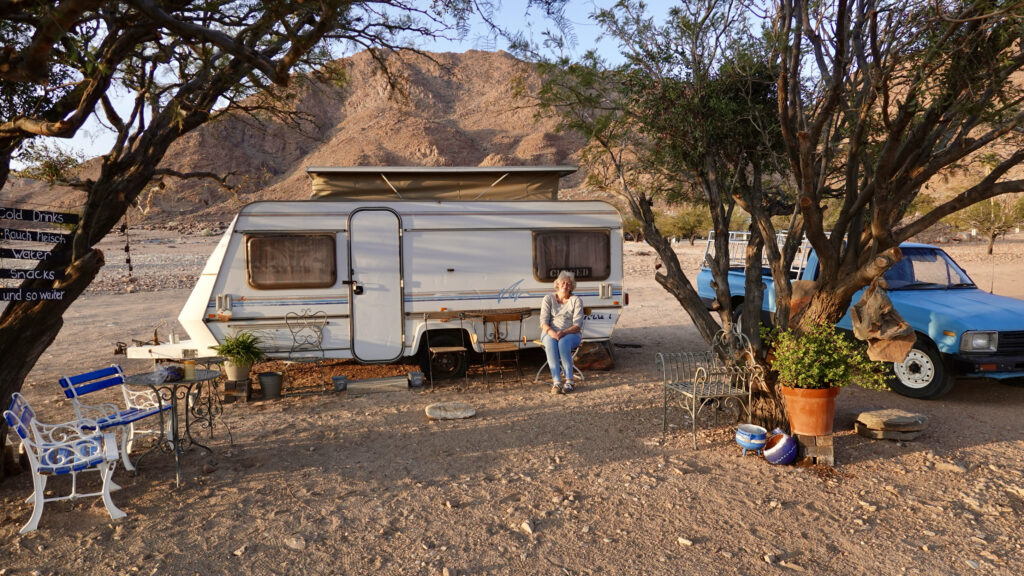
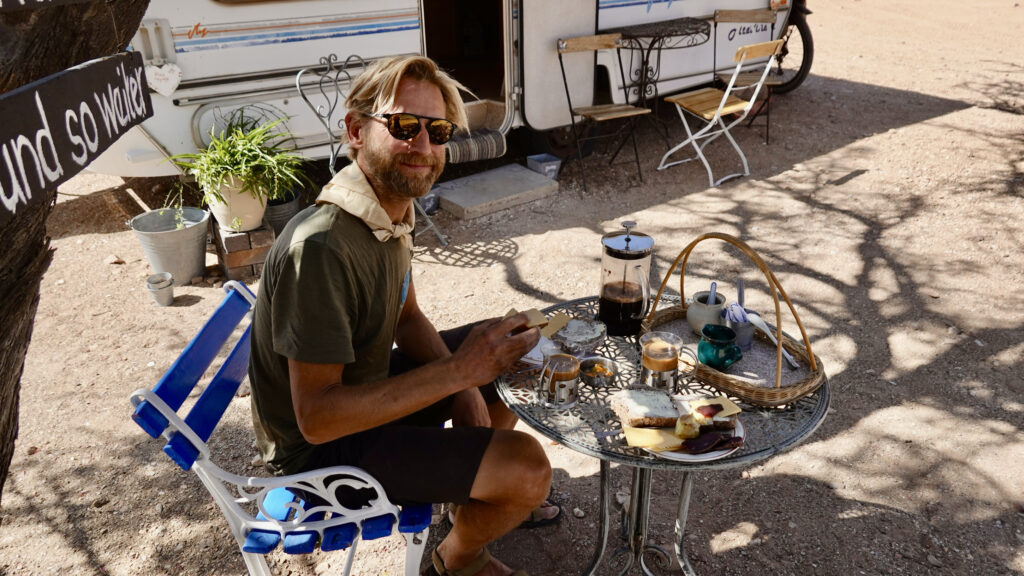
We want to see the old diamond town of Kolmanskop, and we ask MP if he knows of a bus from the next small town, which is 60km away? Kolmanskop is on a main road that goes out to the coast. It is only possible to cycle the same way in and out again, so we would like to avoid cycling to Kolmanskop. Especially also when a cyclist was killed in a traffic accident on the road last year. Driving is really fast on the main roads in Namibia. The MP pulls the smiley face over the question of a bus. There is not much public transport. In return, he and a friend are going to the town of Lüderitz the next day, and they can drop us off in Kolmanskop and take us back again. We smile from ear to ear. It's just so sweet of MP, and it ends with us pitching the tent in their garage sheltered from the wind. Next to beautiful old Land Rovers and a Ford Granada. We also meet MP's mother, Sonja, who is a fantastic older woman with speed. The body is a bit challenged, but what the body lacks in strength, the brain, heart and mood have.
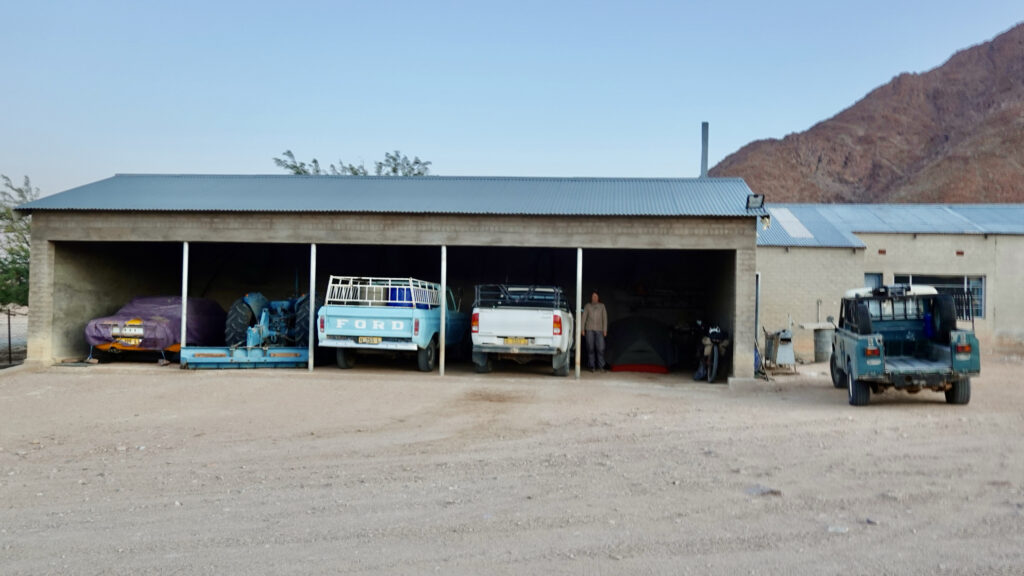
The next day, when we come back from Kolmanskop, the wind has picked up and it's quite clear that we won't get far if we start cycling. Sonja and MP ask if we want to stay, and again we say a big yes thank you in unison.
We travel to meet the locals, but in Namibia it has been more difficult than in the other countries. There is more tourism and far between cities. In addition, only approx. 3 million people in this huge country, which is three times the size of the UK. In addition, we have cycled in the most desolate areas of the country, to experience the great nature. At the same time, many farms are fenced in and with a large padlock on the gate to the farm. In general, we have seen many more fences in southern Namibia.
MP and Sonja are super nice, and it's exciting to learn about their life in the Namibe desert. The oldest desert in the world. MP is the third generation on the farm. The father also lives on the farm, but in his own stone house a few kilometers from the main house. He has been doing that for the last 30 years. It is MP's grandfather who in his time got the land and founded the farm. A huge area of 70,000 hectares. MP did not know how the grandfather got the land. They had come from South Africa and have settled in Namibia.
They live by raising cows, goats, pigs and chickens. But it is no longer easy. We can see that there was once money. There are beautiful old cars in the garage. A light blue old Landrover with round lights. Another recent Land Rover and other great cars. A large house and associated outbuildings. There is a drilling machine for drilling for water. Namibe is one of the driest deserts in the world, and the drought is the worst it has been in as long as they can remember. There has been a drought for 8 years. The water level drops and drops. The grass for the animals on the large areas is disappearing, the fruit trees are gone, and where there was once grass, there is now sand. Then it is difficult to farm.
Every day the shepherd takes the animals up into the mountains to find food for them. Many have sold their farm or the bank has taken it. Their nearest neighbor is approx. 20km away. The nearest small town 60km away, and when they shop they drive 192km. Many young people leave the area, and MP and his best friend, who lives 110 km away, are the only young people left in the area. These are completely different distances and cultivation conditions than we are used to in Denmark.
This also means that they can do everything themselves. They are used to taking care of themselves. They make home-smoked bacon, shoot game and make soap out of the fat from the animals. Sonja pickles and bakes. Nothing goes to waste. It is very inspiring, and it is fantastic to see Sonja's production of home-pickled, boiled and dried ingredients. Even the leaves from the beetroot can be used. She also makes her own 'antibiotics' and cold medicine. We make e.g. onion pie together with Sonja, and Marie gets a few good recipes along the way. When you are so far from everything, you both have to and are used to fending for yourself. Then you are also prepared if the world goes down. They have a concern about developments in South Africa and how it will affect Namibia.
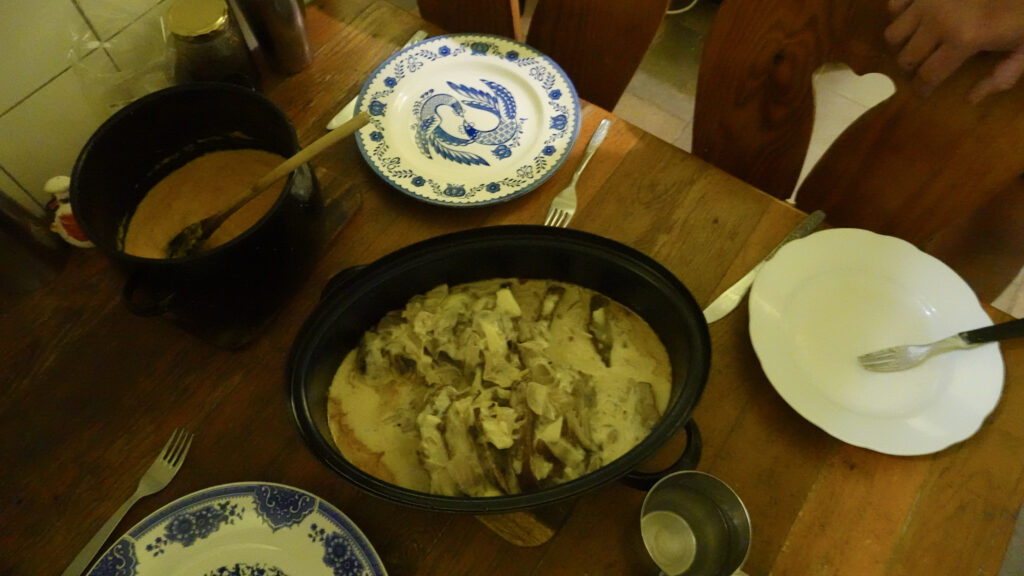
MP loves guns like we love bikes. It is a passion and a hobby. In Namibia you are allowed to have four guns, but when the law was made you were not allowed to take guns from people, so the MP's father has far more guns. MP makes its own bullets, as buying ammunition is an expensive pleasure, and why buy it when you can make it yourself. Kenneth takes them out into the mountains, and they shoot to the target before picking up the shepherd after the day's work. They have two employees on the farm who help them with the day-to-day operations. They live on the farm with their families. Since ancient times, it has been a legal requirement that they have a small farm shop on the farm, from which the employees can buy. It is then deducted from their salary every month.
We'll stay another day. The storm is still fierce and the weather forecast is flashing red. MP and Sonja ask if we want to stay one more day. We would very much like that, because we have a really nice time together with MP and Sonja. MP cooks oryx meat for us in the evening together with pumpkin, onion, garlic, cream and butter. MP jokes about whether we are still hungry and we have to admit that we can't eat more after the delicious dinner.
We see the world from where we live, but the world is big and diverse, and there are so many different ways of living. We are grateful that Sonja and MP shared their lives with us for a while. It is therefore also very difficult to say goodbye and continue on the bike. We have made new friends and they will forever have a place in our hearts.
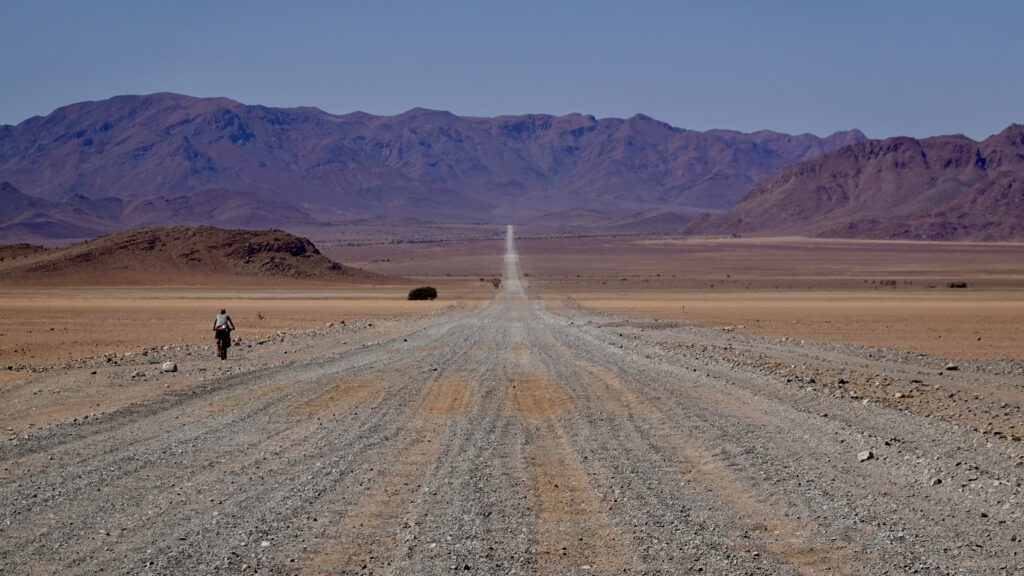
Kolmanskop – diamond fever
In 1908, Namibia was colonized by the Germans, and they were building a railway to the port city of Lüderitz. One of the workers brought a shiny little stone to his German superior, and that was the start of a wild diamond fever in the area. Rumor has it that at first they could pick up diamonds from the surface of the sand as they glinted in the moonlight.
The amount of diamonds meant enormous wealth, which the Germans, among other things, used to build an impressive city in the middle of the desert for 300 people plus their children. There was a shopping street with a grocer, baker, butcher and ice factory. Not the kind of ice cream that we eat for dessert, but ice cream for their fridge. It was made by taking a large vat of salt water in which they had molds of fresh water in. The water was then frozen with ammonia around the outer vessel. Each family was given a block of ice every morning, which they placed at the top of a cupboard to keep their food fresh. As the ice melted during the day, it was collected under the cabinet so that the water could be used again. Together with the block of ice, each family was delivered 20 liters of fresh water. The water was transported by boat all the way from South Africa and by rail from the port city, so it was an expensive affair. But no fresh water had been found in the area yet. Right next to the ice factory was the butcher's block, so that the cold could be used to keep the cold room cold.
The families were not supposed to be bored out in the desert, so a Casino was built where they had entertainment shows and showed films. Of course, there was also supposed to be a bowling alley, and it is still as beautiful as it was then. The children got a swimming pool, and the women didn't have to walk in the sand, so they made a small tram that they could drive the few meters down to the shopping street.
It is also in Kolmanskop that the first X-ray machine in Africa was introduced. Its primary purpose, however, was to investigate whether the workers had swallowed a diamond or two. This happened occasionally, and then they were put on a toilet with a built-in filter and given a laxative. Then they fell into a frenzy. In total, there were 800 local workers who collected diamonds. The workers were primarily Ovambos from northern Namibia, as they were larger and stronger than the nearby Nama people. They lived in an area of their own, without the same luxury as the Germans. So the story is unfortunately the same here, as in so many other countries in Africa.
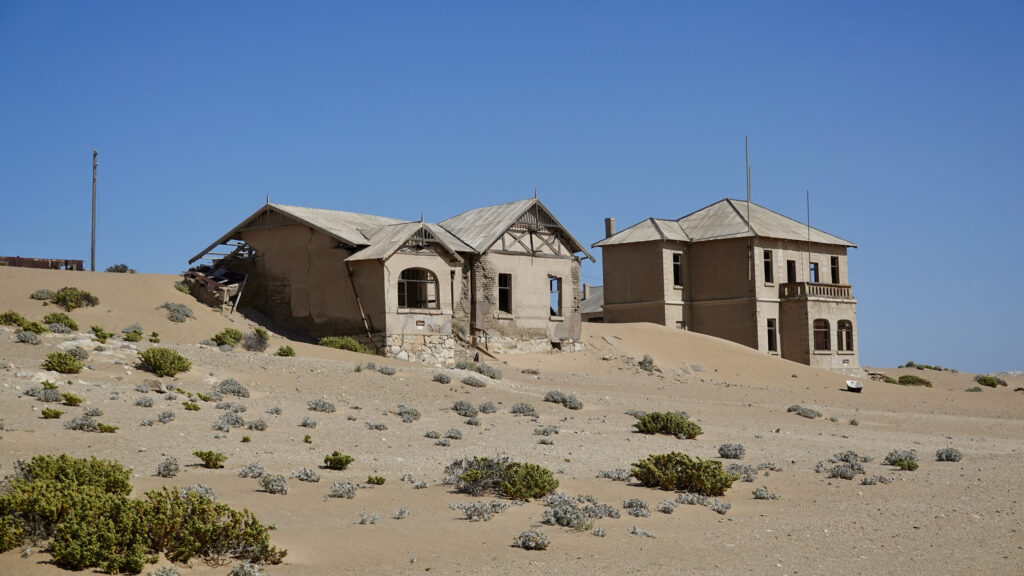
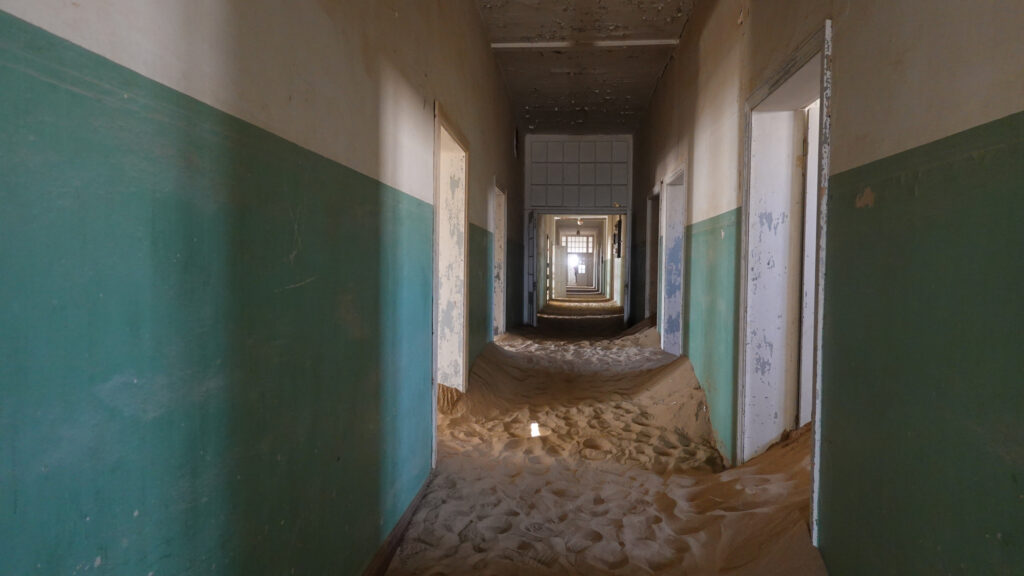
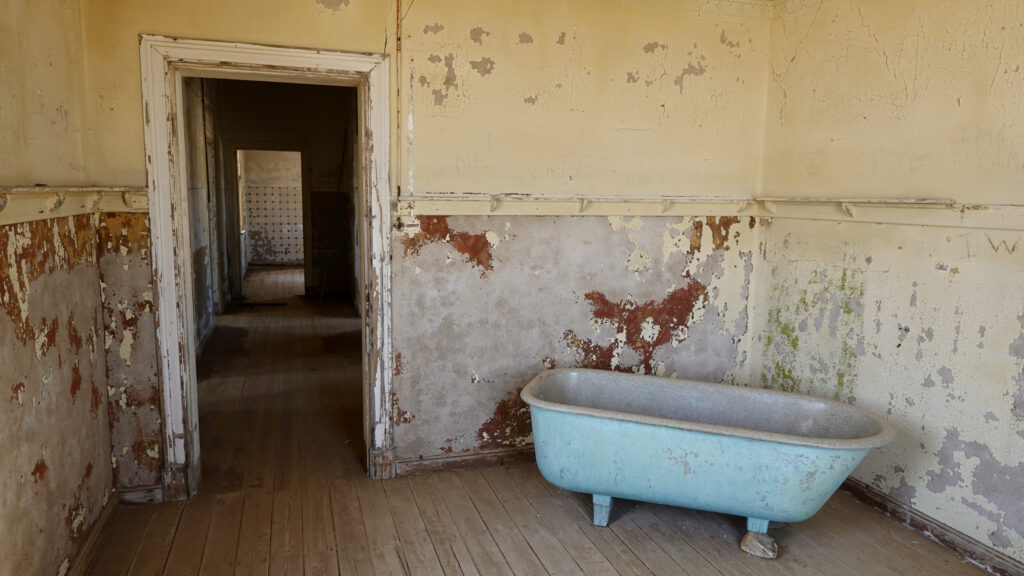
They say diamonds last forever, but not when you have to find them. In the 20s there were fewer diamonds to be found and other areas became more valuable in the diamond hunt. The last residents moved from the town in 1953, when the hospital closed and fresh water no longer came to the town. So the luxury town of Kolmanskop only existed for 50 years.
The town now stands as a ghost town, where the sand just as quietly invades the beautiful old houses. It is possible to enter most of the houses, and it is exciting to see how they are decorated. The rooms are beautiful and the walls are beautifully painted. The floors consist of thick planks, and the stairs to the second floor are still standing. No doubt that they are built with the best materials. Although the town is located in a sandy desert, the Germans imported sand to build the houses from, as there is too much salt in the sand in the area. The windows are large and beautiful, and it is easy to see that there was no shortage of money. It is impressive to see how many feats of engineering genius went into making the city work the way it did.
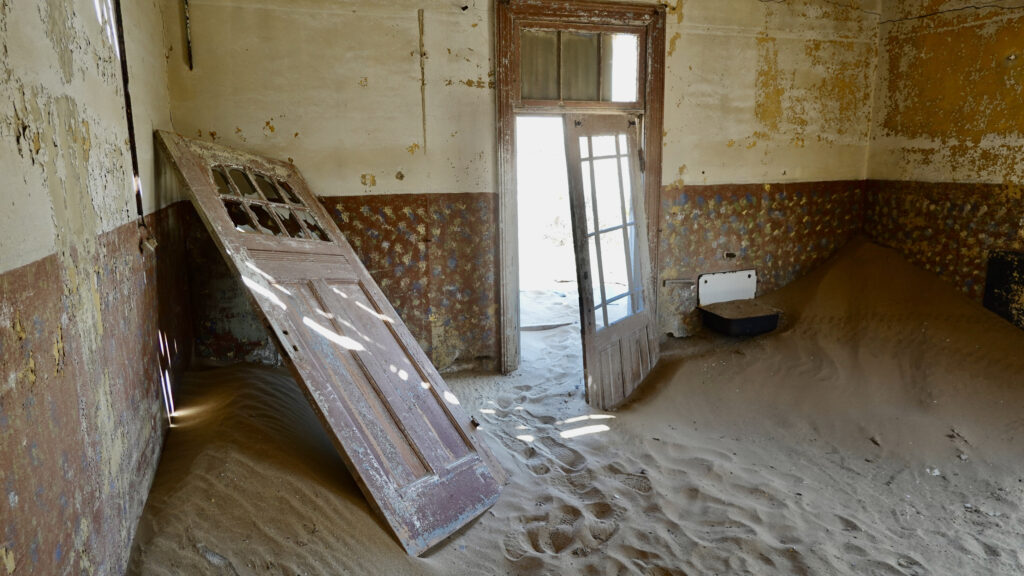
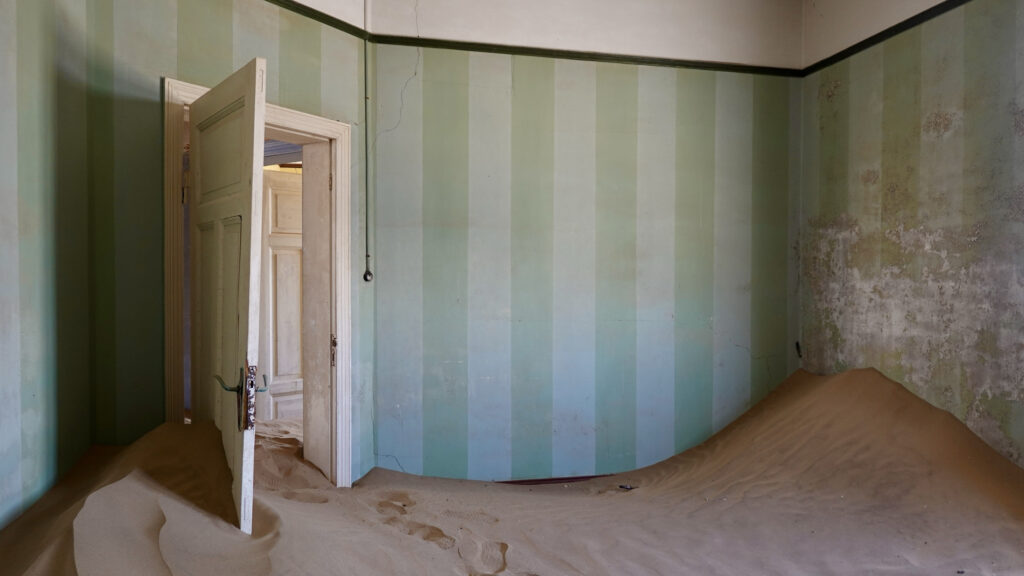

After Kolmanskop, the diamond industry moved to Oranjemund, which was closed to the public until 2014. Diamonds are still mined in the sea off the coast, and for the same reason the beaches are therefore closed to the public.
The geological wonders of Namibia

Soussuvlei and Deadvlei
Sossuvlei is located in Africa's largest conservation area, the Namib-Naukluft National Park, which is 50,000km2 in size. A huge area with high red sand dunes shaped over millions of years. The highest sand dune is 325 meters high with the name 'Big Daddy'. Of course we had to climb it, and it was fantastic to get a view of the area when we reached the top. So much sand, and as Kenneth said when we sat on top of the sand dune: 'It's impressive to think how many grains of sand it takes for us to sit on top of a sand dune'. It is true.


From the top of Big Daddy we can see beyond Deadvlei, which is a dried out clay area formed when the Tsauchab River overflowed. Because of the water, trees began to grow on the site. As the sand dunes blocked the river, the area dried out along with the trees. It is estimated that the trees are 900 years old and have not broken down due to the dry climate. It is almost surreal to stand on top of a large sand dune and look down on the white salt plain with black trees.

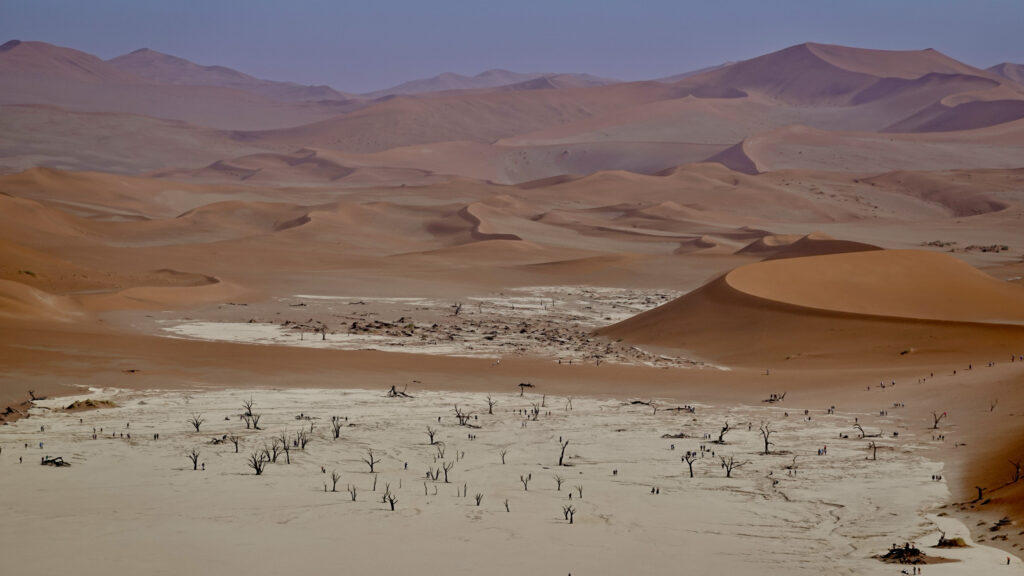
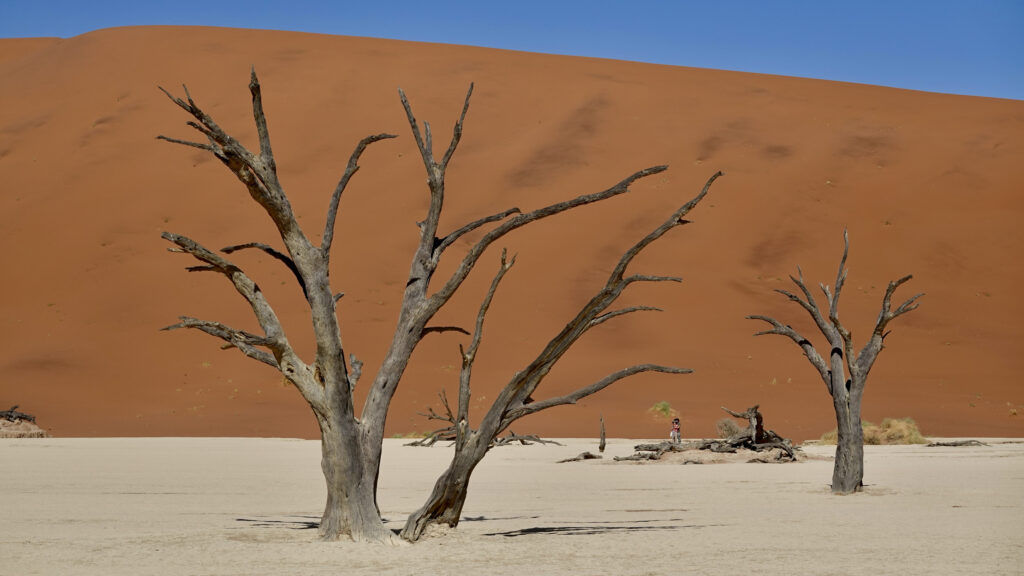
We ran down the side of the sand dune, which is really fun. We can get quite a lot of speed, and it's almost like running in the powder. When we reach the end of Deadvlei, we step from the orange loose sand onto a rock-hard clay bottom, and the white color almost hurts the eyes. As we move towards the other end of the valley, it is almost like stepping into a painting with the white bottom, orange sand in the background, a blue sky and the black trees. We understand that many photographers think this place is paradise.
Fish River Canyon
Another natural wonder that we have been looking forward to visiting is Fish River Canyon. The gigantic gap was created over millions of years. It is approx. 161 km long, 27 km wide and up to 500 meters deep. Depending on how you calculate it, it is the second largest after the Grand Canyon in the United States.
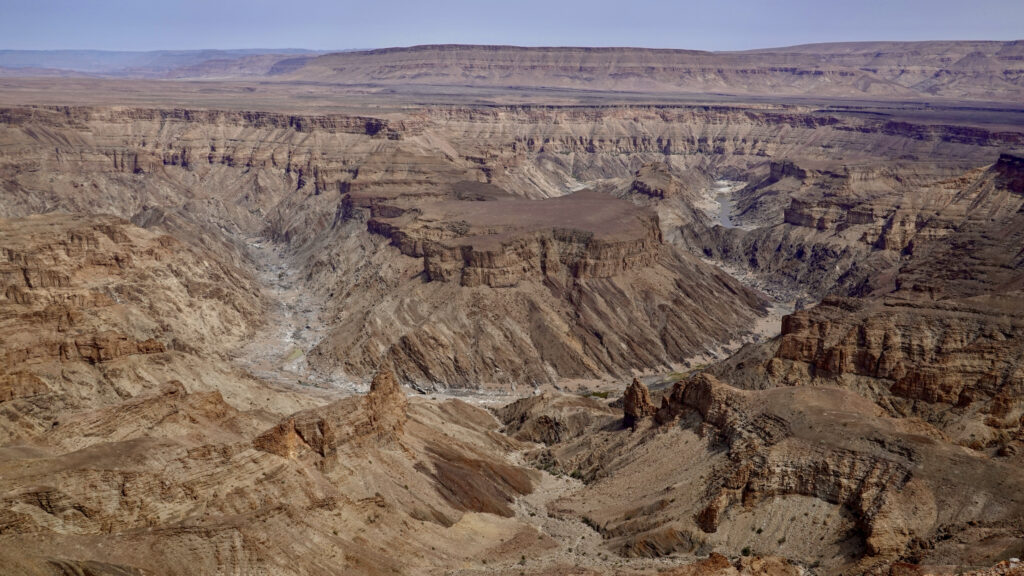

It is again one of those natural phenomena where you just have to polish your glasses an extra time and pinch yourself in the arm to understand that it is real and not a computer-generated image from space. There are so many nuances, shapes and details that we could spend a whole day looking at the gorge from the various vantage points. There is also a hiking trail which runs 80km through the gorge and takes approx. 5 days to complete. The track is closed at this time of year as it is too hot. We sweat just thinking about how hot it must be down in the canyon with the scorching sun. It would otherwise be a fantastic experience to walk through it and become part of life in the canyon.

A hot bath
The day before yesterday we celebrated Marie's 'birthday'. We were in Cameroon in the middle of nowhere in June and we couldn't even find cake on the day. These are serious first world problems. So we agreed to postpone the birthday.

The birthday starts with us fishing the bikes out of the bath at a campsite. In the dead of night in the tent, Marie heard a sound. A new sound. It is usually a Jackal or perhaps the hooves of Oryx. The sound was coming from the bikes, and that's never a good sign. Marie wakes Kenneth, who is sleeping with the tent open to the bikes. He quickly opens the tent cloth and shines a light on the bikes. A giant shrew – with emphasis on giant – is about to break into Marie's small side bag with its sharp claws. It has managed to scratch the strap and make a hole in the bag. The only thing in the bag is an unopened loaf wrapped in plastic from the manufacturer. The porcupine doesn't see very well, but it has a phenomenal sense of smell. Really impressive that it could smell the bread. We are equal parts impressed by the sight of the porcupine and honest that it has ruined the bag. It comes again a little later, as expected, so we end up hiding the bikes inside the bath behind a closed door overnight.
We are often asked if we have had encounters with wild animals, and we always laugh as we reply: 'Only at campsites'. Last time, however, it was a dog that stole our food, so it probably cannot quite go into the category of wild animals.
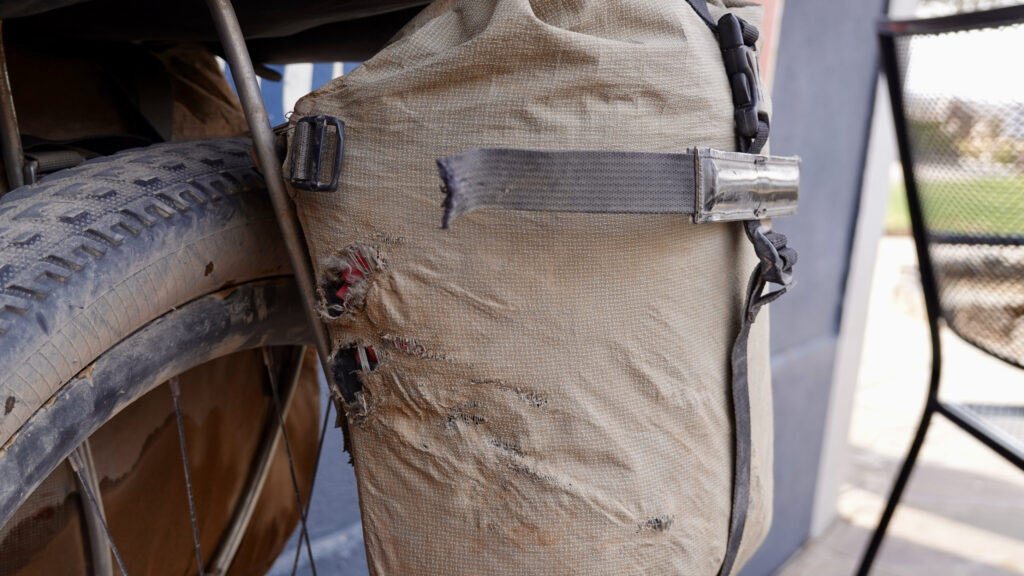
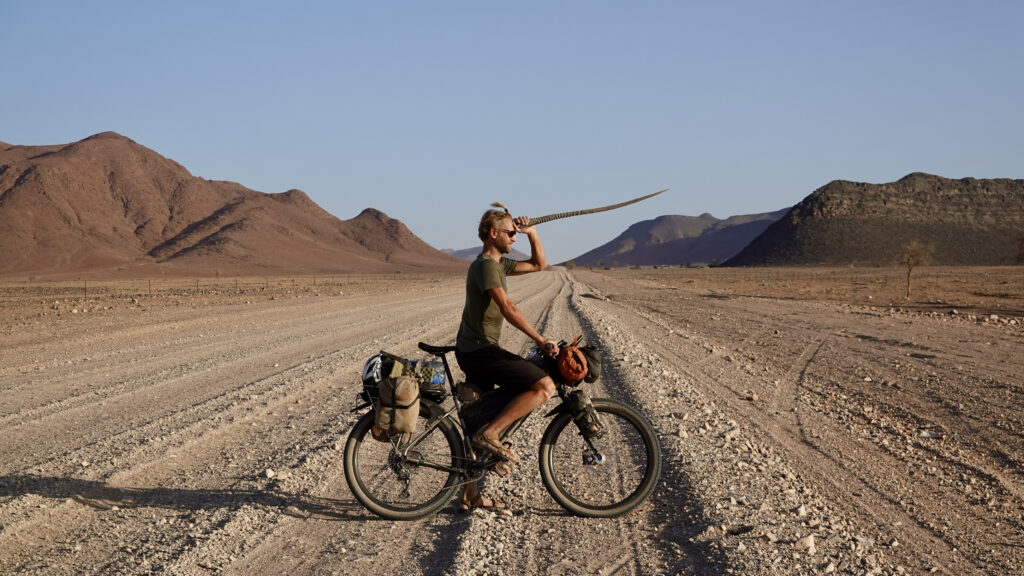
After a short day on the bikes, we change the tent to check into a lodge. Here we are shown down to a delicious cabin, which is built into the mountains and overlooks the desert. The style is complete and also inside the hut it is built up and around the stones. We get the best bath with hot water, delicious products, and we can dry ourselves in big good towels. Marie enjoys every minute with fragrant shampoo, conditioner and body lotion. The bed is lovely and the pillow perfect.
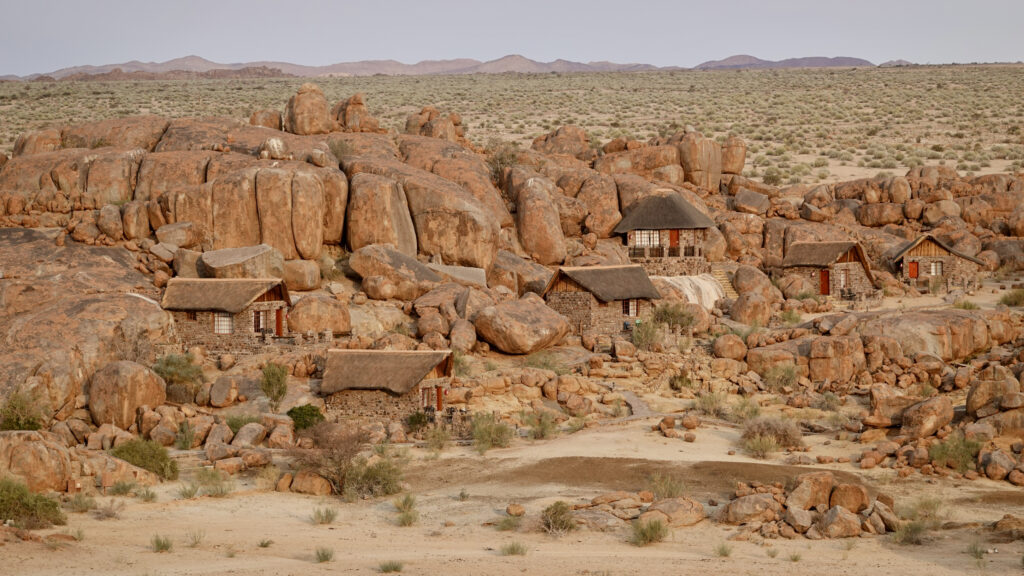
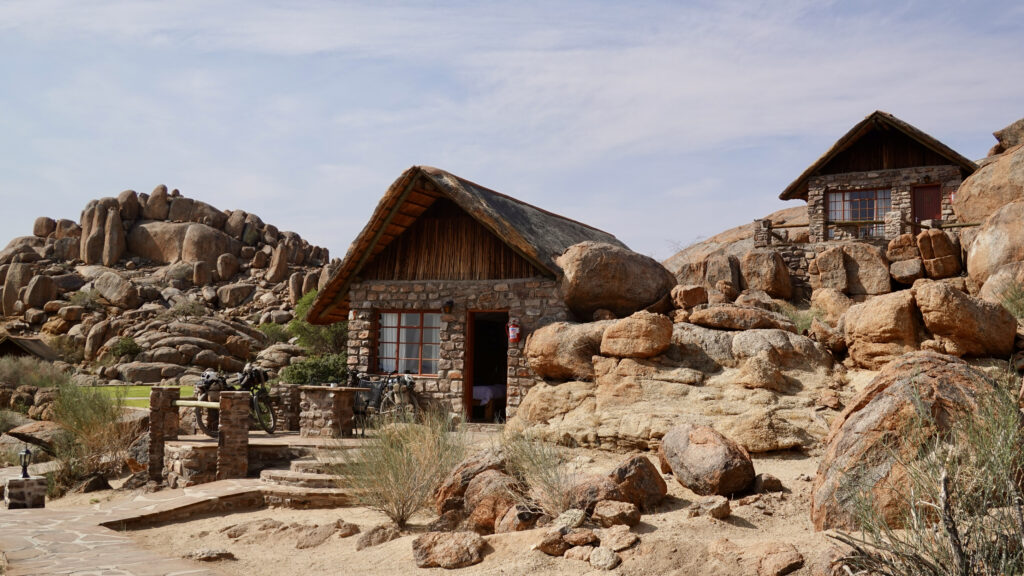
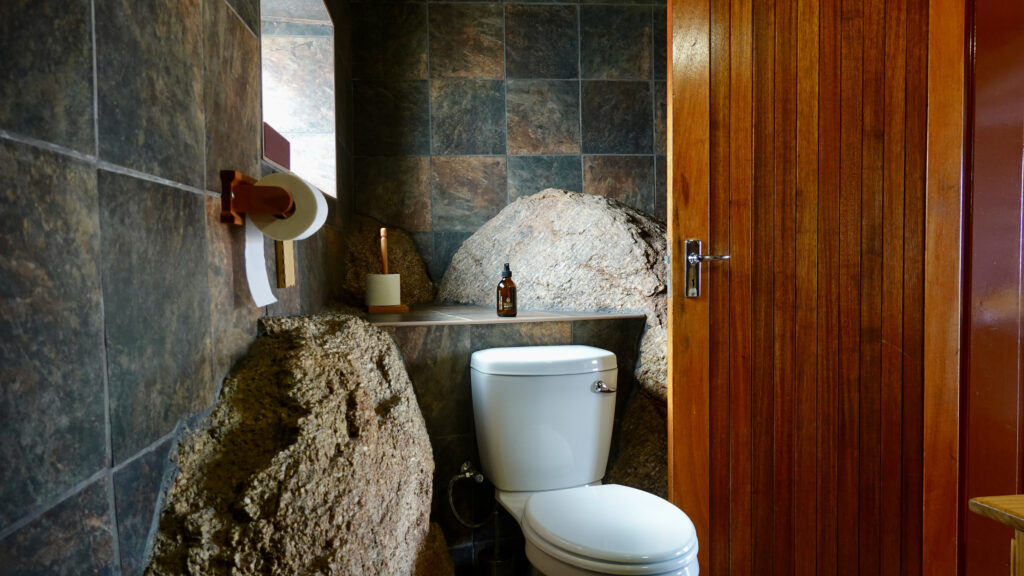
A bonus of cycling for so long is that we really appreciate a good bath, which we may take for granted when we're at home. But there really is nothing better than standing under the shower, turning on the hot water and rinsing off the dust. The pampering continues with a three-course evening menu and a bottle of wine. There is a variety of game on the menu; springbok and oryx. They eat a lot of game in Namibia, and it is delicious meat, since the animals run freely in the wild. The best thing is that there are more than two ingredients on our plate, and it is also an orgy of color with different vegetables. Usually we eat quite simply on the bikes. Boats to run as easily as possible, and the food must be able to stay warm. Tomorrow we will again sit on the ground and eat out of the pot in front of our tent in a small Canyon. We love that, but it's also great to have an evening of pampering. Contrasts are fantastic and bring out the best in both.
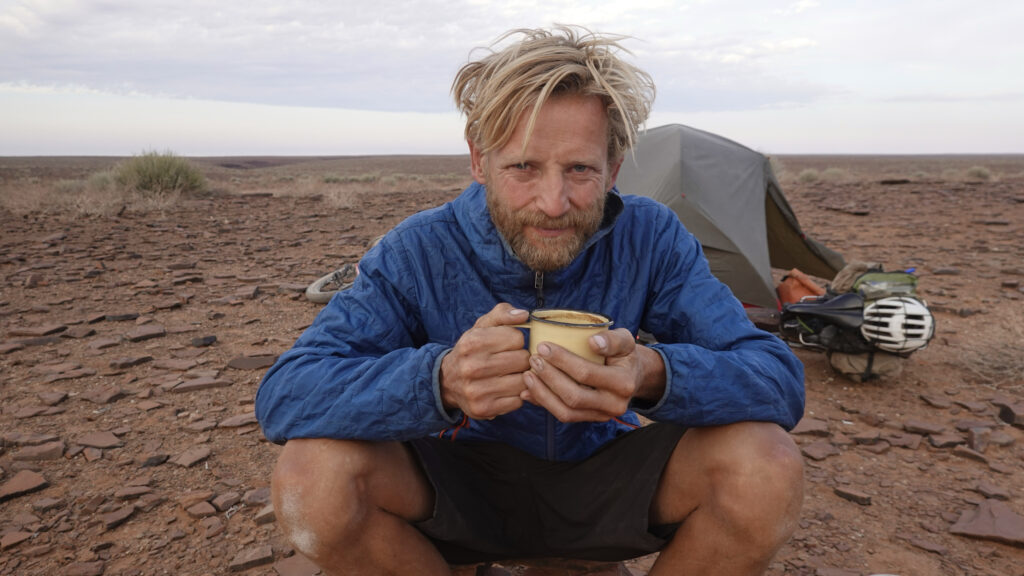
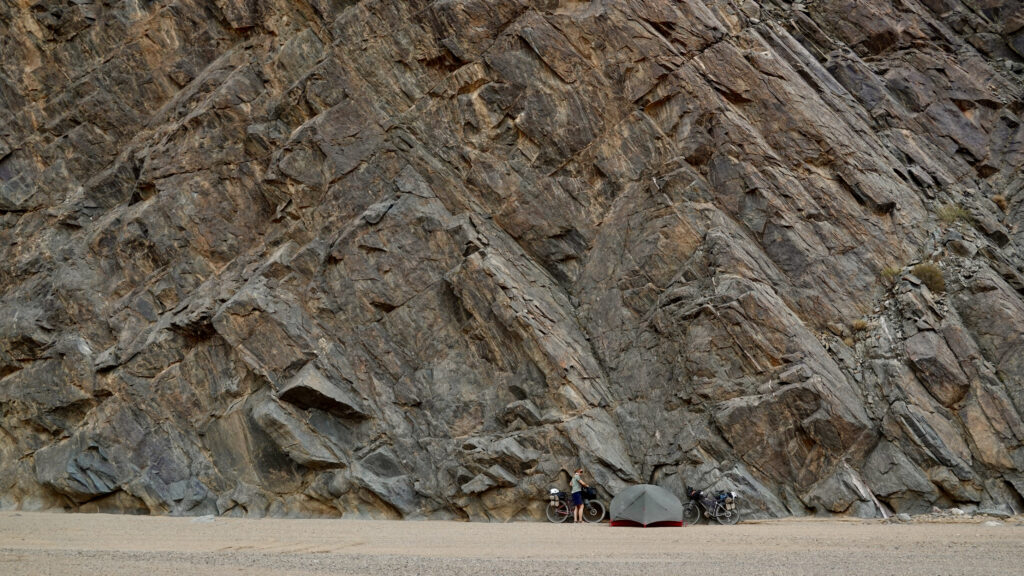
Thanks for this time, Namibia
Southern Namibia is impressive with its beautiful landscapes, which continue endlessly on the deserted country roads. There is no doubt about the power of natural forces. How eight years of drought can turn people's lives upside down, and we see with our own eyes how water equals life.

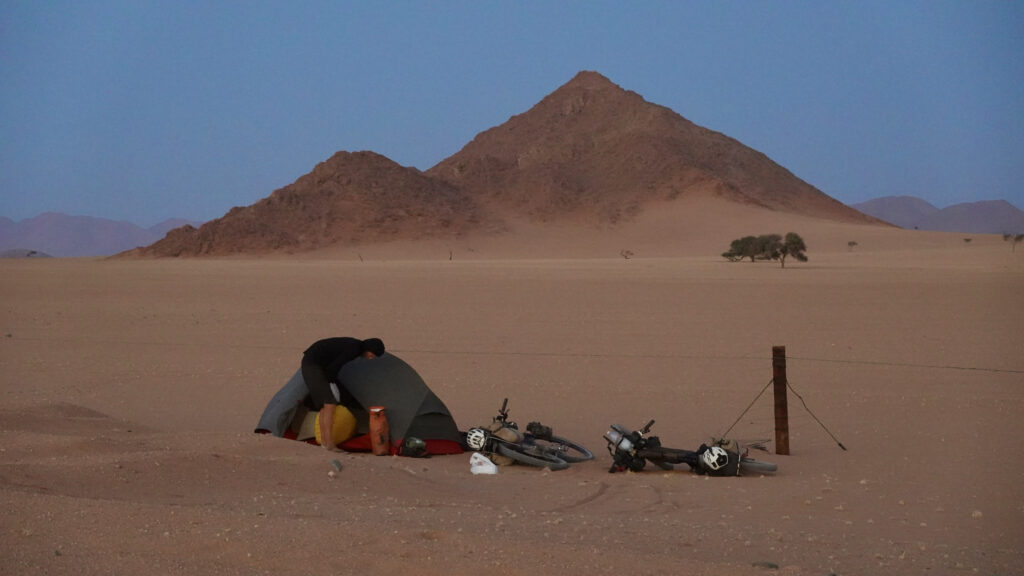
We have been in Namibia for approx. six weeks and enjoy every day the great nature and being able to pitch the tent almost anywhere with beautiful sunrises and sunsets. Since August 1, when we were in Angola, we have slept in the tent every night (apart from the birthday celebration), as it has been so nice and easy to wild camp or sleep in camps in both Angola and Namibia.
In Namibia we also crossed 27,000 km since the North Cape, and we are now approx. 100km from the border crossing to South Africa. The last country on the journey. It is both wild and exciting at the same time. We are very much looking forward to exploring the country and visiting our friends in Cape Town when we get that far.
